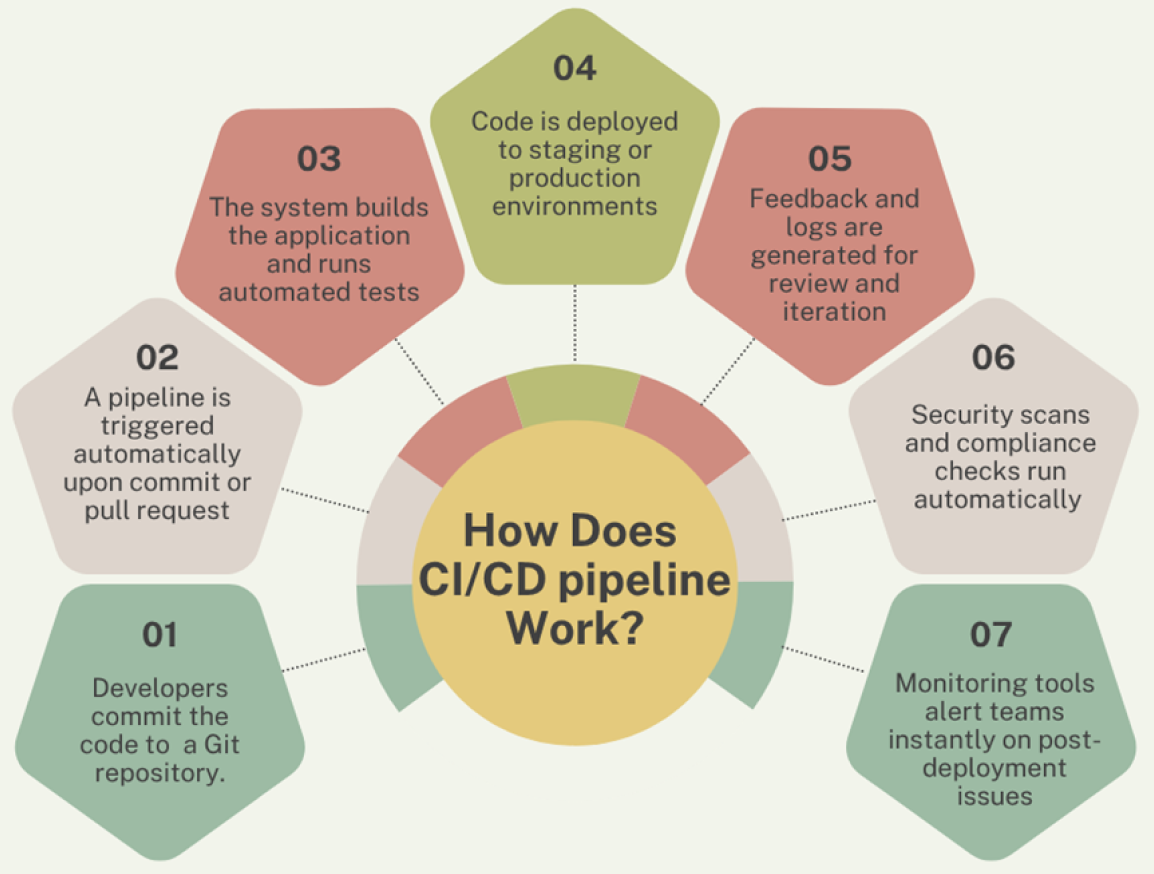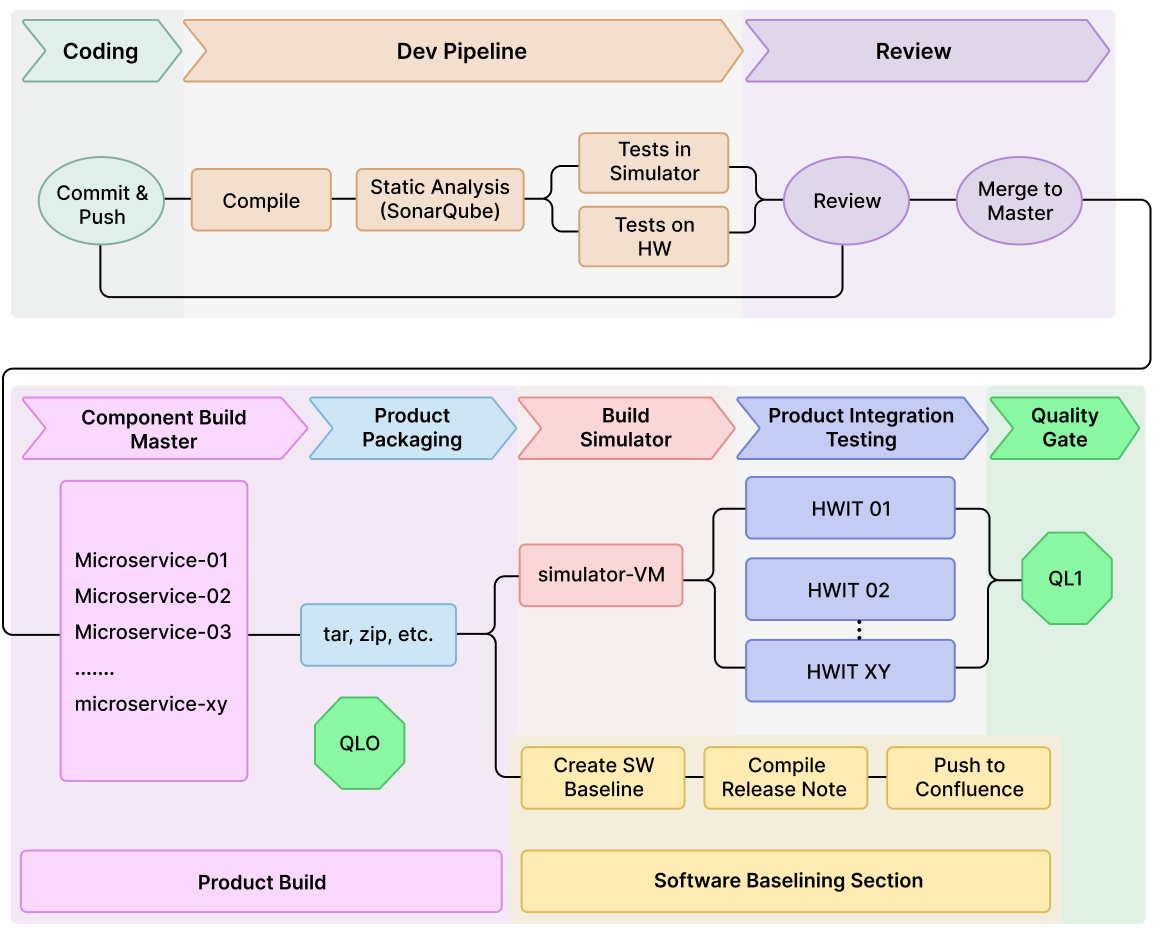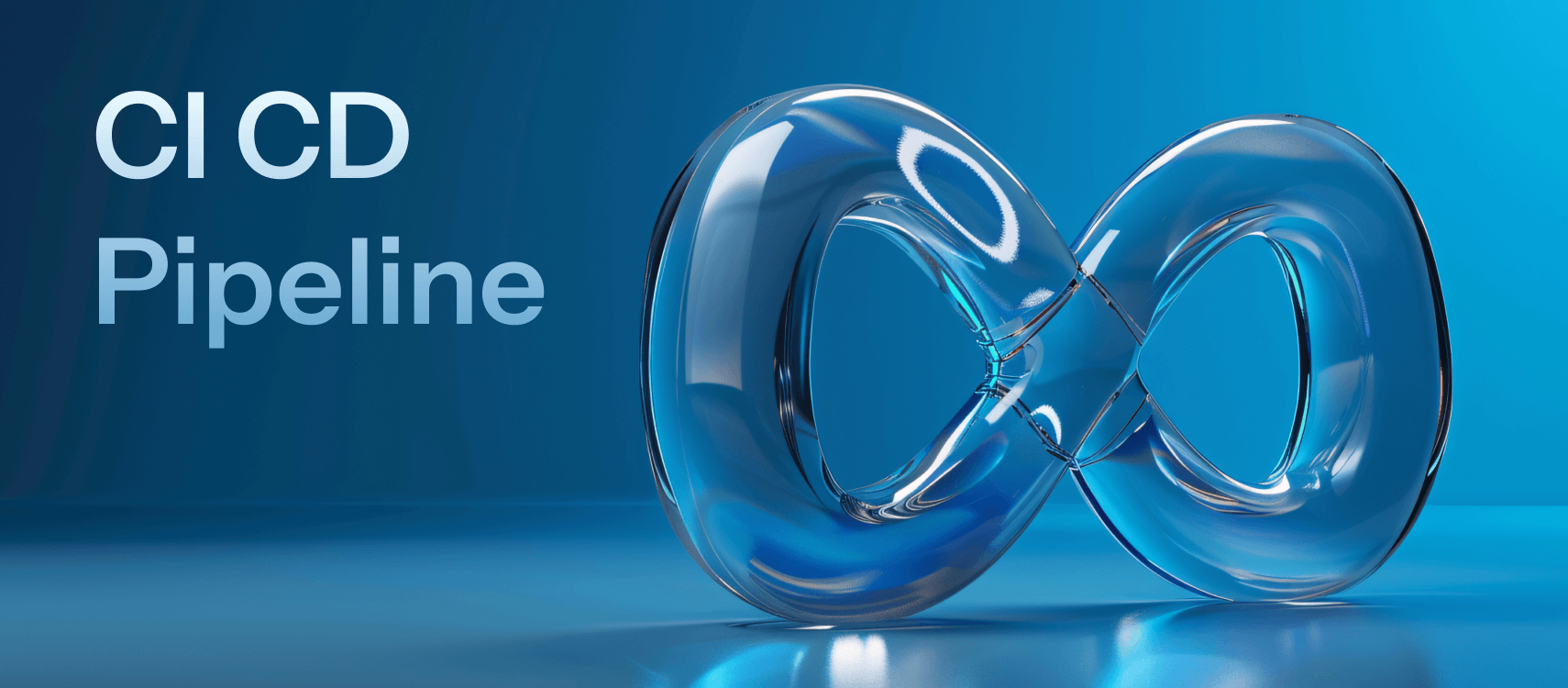Table of Contents
- What is CI/CD Pipeline
- How Does CI/CD Pipeline Work
- Why Use a CI/CD Pipeline
- CI/CD Pipeline Tools
- Visualizing The CI/CD Pipeline
- CI/CD on Kubernetes and the Cloud
- Why Security Matters
- Security Best Practices
- CI/CD Pipeline vs CI/CD Development
- Real-World CI/CD Pipelines
- Benefits and Impacts
- Final Thoughts
- Frequently Asked Questions
In modern software development, maintaining quality while ensuring regular updates is essential. Continuous Integration/Continuous Delivery (CI/CD) offers a structured and reliable approach to automate how code is built, tested, and deployed. It enables development teams to deliver changes more frequently and consistently, with fewer errors and minimal manual intervention.
At the core of the process is the CI/CD pipeline – a series of automated steps that carries code from a developer’s desk to a delivery environment. This includes collaboration, the promotion of code quality and less time and effort spend on your traditional testing and deployment process.
In this blog we are going to see what is ci cd pipeline, the tools involved, real cases and best practices to help you to bring a smooth and secure development cycle.
What is CI/CD Pipeline?
Before we can know how it works, let’s get a grasp on the ci cd pipeline meaning. CI/CD pipeline is an automatic process in which the code is moved from development to production environment with less human interference. CI/CD pipeline definition boils down to accelerating and controlling code delivery, so that more of that end-to-end process is dedicated to innovation and less to manual testing and deployment.
The commuter software CI/CD pipeline should at least contain the following stages:
- Code Commit: Developers push their code changes to a shared repository (e.g., Git).
- Build: This system is building the application.
- Automated Tests: Unit, Integration, and security tests are run.
- Staging Deployment: Code is deployed to a separate staging environment and tested.
- Production: Push the code to Production once all checks are successful.
At each step of the automated CI/CD pipeline, the goal is to detect errors early and to release only validated code.
How Does CI/CD Pipeline Work?

The CI/CD pipeline automates all the manual steps involved with code integration and deployment and helps release software faster and with confidence to serve the market well. But how does CI/CD pipeline work in practice?
It starts when developers check in code changes to a shared version control system (VCS) such as Git. This will then automatically execute a number of pre-configured tasks including the app to be built, automated testing, security scanning and deployment of the code into a staging or production environment.
Every stage of the pipeline is automated and runs in a predictable order, which reduces the requirement for manual interaction and human error. Jenkins, GitLab, and GitHub Actions are typical tools to specify and control these pipelines.
For instance, in Git CI/CD pipeline, you can setup to perform builds and unit tests execution each time a PR is submitted, and never miss any issues discovery and review activities during your projects.
A well architected CI/CD pipeline is key to keeping codebases stable, promoting ci cd pipeline integration often and enabling fast delivery.
Important stages of how a CI/CD pipeline operates:
- Developers commit the code to a Git repository (GitHub, GitLab etc.)
- A pipelie is automatically start on commit or pull request
- The app gets built by the system and automated tests get executed
- Deploying code to our staging or production environments
- Feedback and logs are created for review and iteration
- Security scans and compliance checks run automatically during each pipeline stage.
- Monitoring tools alert teams instantly on post-deployment issues or failures.
Why Use a CI/CD Pipeline?
If you’re here asking yourself how does CI/CD pipeline work, the answer hides in the fact that it can automate repetitive tasks, avoid human error, and ensure predictable outcomes. It reduces the chances of integration problems for development teams and also makes it possible to get quick feedbacks for the quality of developed code. Also, CI/CD pipeline development creates a culture of making small, frequent changes that can be easily tested and deploy.
- Facilitates iterations between developers and QA throughout the cycle.
- Helps to quickly find and fix any bugs or integration issues.
- Promotes team collaboration with the ability to check in code, early and often, to a centrally accessible go-between repository.
- Enables faster time-to-market, which is a business imperative.
- Minimizes deployment risk with automated and standardized testing practices.
CI/CD Pipeline Tools
Today, there are numerous CI/CD pipeline tools in the marketplace to support the varied stages of development and deployment. Here are some of the top CI/CD pipeline tools:
- Jenkins: it is the most widely used open-source tool to create a ci cd pipeline jenkins.
- GitLab: Provides version control include with a CI/CD pipeline, which is called GitLab CI/CD pipeline.
- GitHub Actions: There are ways to run your workflows and automate in the GitHub CI/CD pipeline.
- Azure DevOps: A Unified platform that provides end to end experience for the Azure DevOps CI/CD pipeline and a rich set of Microsoft services.
- AWS CodePipeline: Makes it easy to create AWS CI/CD pipeline for deploying applications at scale.
- Lightspeed: Fast automation as part of the lightspeed ci cd pipeline system.
All of the best ci cd pipeline tools above can be leverage to construct continuous workflows specific to project needs.
For an Azure CI/CD pipeline example, above components might be link together with Azure Repos, Azure Test Plans, and Azure Kubernetes Services (AKS) for automatic deployment. On the contrary, a Git CI/CD pipeline may employ git hooks to initiate builds and tests on each commit.
Visualizing The CI/CD Pipeline

Teams frequently rely on CI CD pipeline diagram to ease out confusing pipelines. This visualization decomposes the steps involved and where transitions occur from commit to deploy. A clear CI-CD pipeline diagram will help you to find bottlenecks and make sure the ci cd pipeline automation is doing its job properly.
Additionally, diagrams provide a lingua franca throughout Dev, QA, and the Operations teams. They facilitate in communicating the structure of the pipeline, finding redundant steps and missing ones, and documenting modifications as the workflow evolves. Feeds or pipelines visualization improves the transparency and accountability, especially in large projects with multiple simultaneous stages and dependencies.
CI/CD on Kubernetes and the Cloud
Pipeline designs are strongly influence today by cloud-native technologies. A Kubernetes ci cd pipeline is an archetypal case of container-native delivery. These pipelines typically leverage tools such as Helm, Argo CD or Flux, for orchestrating deployments across Kubernetes clusters. In the same way you can build an AWS CI/CD pipeline solution using CodeBuild, CodeDeploy, ECS or even EKS clusters.
Why CI/CD Pipeline Security Matters?
CI/CD is about security just as much it is about development. With a safe CI/CD pipeline, you won’t introduce vulnerabilities into a production environment. CI/CD pipeline security best practices Implementing best practices when it comes to CI/CD pipeline security should cover:
- Running static and dynamic security scans in the pipeline.
- Using Role Based Access Control (RBAC).
- Securely saving secrets with the help of secret managers.
But security is more than just scanning and role assignment. Each piece of your pipeline, and each place you integrate, is another place where data can be attack. This is why it’s important to have a defence-in-depth strategy in place, securing your code, configurations, and infrastructure with multiple layers of security controls.
Deploy minimal-permission access controls, configuring every tool and user to have only the absolute minimum access they require. Check the access logs and turn on auditing to identify things like this before they become a problem. Always sign changes and validate cryptography that was use.
The treatment of secrets is especially important. Don’t hard-code the credentials in your code or configuration files. Instead, use environment-specific secret managers like HashiCorp Vault, AWS Secrets Manager or Azure Key Vault. Rotate secrets frequently and monitor access patterns.
Also, do your best to keep your dependencies updated and with no known vulnerabilities. Automate security scanning of third-party libraries with applications like OWASP Dependency-Check or Snyk.
By building security in at the onset DevOps CI/CD pipeline, teams follow a shift-left security approach, mitigating risk while maintaining governance requirements. Secure pipelines build trust for your users and remain compliant.
CI/CD Pipelines Security Best Practices
These CI/CD pipeline best practices will help you maintain an optimal, efficient, and productive workflow:
- Fail Fast: Construct the pipeline to fail quickly & noisily. This saves time and money. Fast red/green feedback found on failures helps developers respond quickly with #failfast, rather than allowing broken builds to travel further downstream through the pipeline.
- Parallel Testing: Increase the speed in the pipeline with parallel testing. Your test cases will be able to spread across different environments or threads, which will reduce execution time for quality assurance.
- Automate Everything: If it is automate there are no human errors. Continuous integration and deployment lead to consistency and reliability across your deployment environments, including both builds, tests, deploys, and yes, even rollbacks.
- Isolate Environments: Utilize an isolated staging environments for pre-deployment testing. These environments must be as production like as feasible, so that realistic testing can be perform, but without affecting live systems.
- Monitor and Alert: This includes logging and monitoring and alerting for early detection of failures. Instant insight into pipeline health and other performance metrics enables quick detection of problems and facilitates team accountability.
These are the best practices to make sure your CI/CD pipeline automation is both efficient and robust. Their adoption encourages a culture of continuous improvement, mitigates risks, and provides a fast, safe avenue for software delivery.
CI/CD Pipeline vs CI/CD Development: What’s the Difference?
Although CI/CD pipeline and CI/CD development are frequently used interchangeably, they are actually two different facets of the software delivery process.
The CI/CD pipeline itself is the automated workflow or pipeline that the code changes through, from development, testing, deployment, and delivery. It’s a technical novelty that has been create to automate going through the build, test and deployment in different CI/CD pipeline tools such as Jenkins, GitLab, Azure DevOps or GitHub Actions. It’s essentially the what, how and where of how integrations are done, how code is validate, where it is deploy, and how mistakes are reported and fixed. It is what you construct and maintain to achieve fast, reliable software delivery.
CI/CD development, on the other hand, refers to the extended practice or methodology of developing software with CI/CD in consideration. It involves the cultural change in writing, committing, testing and releasing the code as a team. This includes embracing best ci cd pipeline, shaping team processes around agile workflows, and bringing in the tools that enable faster feedback and iteration loops.
| Aspects | CI/CD Pipeline | CI/CD Development |
| Definition | A series of automated steps for building, testing, and deploying software | A software engineering practice focused on frequent integration and delivery |
| Focus Area | Implementation and execution of automation processes | Development methodology and cultural mindset |
| Components | Build systems, testing frameworks, deployment scripts, integration tools | Code writing, feature planning, version control, collaborative workflows |
| Objective | Automate and streamline the software delivery process | Enable rapid and reliable software changes through iterative development |
| Tools Involved | Jenkins, GitLab CI, GitHub Actions, Azure Pipelines, AWS CodePipeline | IDEs, Git, project management tools, and collaboration platforms |
| Responsibility | Typically handled by DevOps or automation engineers | Primarily led by developers and cross-functional teams |
| Output | A functional, automated pipeline that delivers code to production | Regular, tested code changes ready for deployment via the pipeline |
| Scope | Technical and operational | Strategic and procedural |
| Example | Jenkins pipeline that compiles, tests, and deploys code to a Kubernetes cluster | A team pushing small commits frequently, following agile sprints and test-driven development |
Real-World CI/CD Pipelines to Learn From
Below are few ci cd pipeline examples from different world:
- Jenkins CI/CD Pipeline: Written in Java, we build a web app with Maven, test with JUnit, and deploy with Docker and Kubernetes.
- GitLab CI/CD Pipeline: CPython pushed to GitLab => Linting => Pytest => Autodeploy to Heroku.
- AWS CI/CD Pipeline: A Node.js app to CodeCommit to trigger a CodePipeline workflow with CodeBuild, CodeDeploy, and CloudFormation.
- Azure DevOps CI/CD Pipeline: A. Core application with the ci cd pipeline azure with embedded test reports and dashboard.
Every one of these CI-CD pipeline examples shows just how flexible and powerful these automated systems can be within any ecosystem.
CI/CD Pipeline Explained: How it Benefits and Impacts You
To sum up the CI/CD pipeline explained in simple terms: it is a repeatable and scalable method to ensure your code is always ready for production. Regardless of whether you’re an independent developer or being part of a larger team, a CICD pipeline helps you in making your releases reliable and more frequent, ensuring a better quality of your code.
Adoption of good CICD pipeline practices often allows teams to, in general, ship software updates with more confidence, more often, and with less bugs. A mature pipeline, with shortened feedback loops, higher testing coverage, and security scans integrated, is the foundation of a high-performance development environment.
Final Thoughts
Then, what CI/CD pipeline actually is? It’s not just about automation or accelerating deployment – it’s also about building a repeatable and scalable process around ongoing innovation. Adopting CI/CD enables better collaboration between developers and operations teams, which can move quickly and in small increments to manage change and keep software quality high.
Whether you are working with a Jenkins CI/CD pipeline, Git CICD pipeline or grabbing a cloud-based CI/CD pipeline Azure or CI CD pipeline AWS solution, the principles are consistent: automate, check validate, and deliver with confidence.
The CI/CD pipeline will become increasingly efficient and smart with the evolution of tools and platforms. With AI-driven optimisations and greater security and compliance automation, the next generation of CI-CD pipeline integration represents the dawn of a true dev and ops bridge – one commit at a time.










